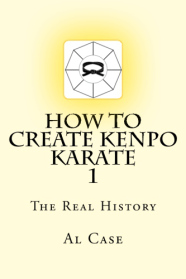Newsletter 943
Defeating the Linearity of Karate
I was watching videos
of people doing karate on the internet.
This included demo teams,
old masters,
and whoever,
and I was struck
by wrong they are doing karate,
by how they didn’t really know karate.
The funny thing is
karate is one of the most powerful arts I know,
yet everybody is doing it wrong.
Let me give you one example.
Watch a video on youtube,
watch a demo team for karate.
They are fast, powerful, explosive.
It is not good karate.
Why?
Because their arms and legs move back and forth
in a linear manner,
stopping and starting.
Real karate is liquid,
it does not stop and start.
At the end of every movement there is a circle,
often too small to be easily seen.
this circle avoids the stopping and starting of the muscles.
It takes effort and muscular exertion
to stop and start muscle motion.
When you have a small circle
somewhere in the end of the motion,
which leads into the beginning of the next motion,
you are doing real karate.
Now,
those who don’t understand will argue,
that is okay,
they will remember
and eventually come around.
For those of you who are frowning,
standing up and checking to see
if you have a little loop on the end of a punch or block
(both ends)
the truth is dawning.
Karate is not linear.
It is not a rigid piston effect,
it is a looping,
neverending effect.
And,
what do you get out of it?
The loop helps change one move into the next
the loop saves energy and is more efficient
it is faster
your body becomes more liquid,
more fluid,
you start to develop ‘pulsing power.’
Pulsing power is when you…
push with the legs
turn the hips
throw the punch.
Not exactly together,
but one…two…three,
so fast that the punch becomes one motion,
each action lending power and energy to the next action,
and yet becoming more and more fluid.
Now,
I read of this concept originally
while reading books on Chinese martial arts.
And,
I observed my instructor,
who was quick and whippy,
fluid like a striking snake.
And I read about a more fluid karate in Shotokai
(not shotokan)
which is supposed to be the style
funakoshi handed down his lineage to.
And I thought about it,
and developed it,
and came to realize the truth of it.
So take your time,
practice your forms,
and search for places where you can
add a loop at the end of a technique.
Maybe it is in the motion of the hand,
maybe it’s a turn of the hip,
a sink of the hip,
and flip of the shoulder.
Whatever it is,
you’re now on the path to true karate.
And,
all these guys doing wrong karate?
They are phenomenal,
not to be disrespected,
but it is a simple matter of physics
that reveal them to be expert beginners,
even master beginners,
who haven’t made the transition past beginner,
into the real thing.
When I teach karate to newbies
I usually let them work on the piston effect.
But when they are starting to remember everything,
I shift them to the looping effect.
Now,
I don’t talk about the whiplike effect much,
I instead recommend people do Matrix Karate,
but if you have matrix karate under your belt,
you could look at Temple Karate.
I do more advanced forms there,
and you can probably,
if you have a quick eye,
see how I add the teensiest of loops
to make my karate fluid.
But your eye has to be quick,
because the longer you train,
the smaller your loops become
until no one can see your loops.
Have a great work out!
Al
Matrix Karate
Temple Karate
Following is a great win that shows one thing…you aren’t going to get the answers, you are going to get the questions, the questions that lead you to understanding your own martial art. Do you have the kind of mind that can do this?
A WIN!
I picked up Matrix Karate from you; and I definitely get it. My area of study is Kajukenbo; and based on watching the Matrix Karate DVD last night, I am reasonably sure that matrixing Kajukenbo would be very straight forward. Time consuming, yes, difficult no. I think it would be best to break Kajukenbo into its 7 arts (Karate, Judo, Jiujitsu, Kenpo, Boxing, Kung Fu, and Escrima), and matrix each of those. My questions are: do you think that is the right approach? Is there a particular order you think these should be taught in? Do you teach each matrix’d art to completion, then move to the next? And, how does sport karate fit in? And finally; for the traditional forms, would those be one entire section? Or would you recommend splitting them into each sub-section of the art?











